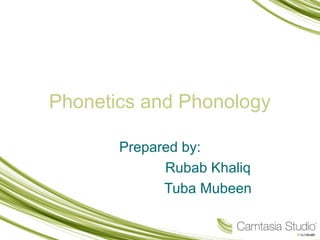
Phonetics and phonology
- 1. Phonetics and Phonology Prepared by: Rubab Khaliq Tuba Mubeen
- 2. Sub Headings 1.Introduction 2. Phones and Phonetics 3.Types of Phonetics 4.Classification of Sounds 5.Vocal Tract
- 3. Introduction • Phonetics: • It deals with physical side of speech. • Phonology: • It deals with mechanism of speech sound. • The two primary linguistic disciplines concerned with speech sounds - those sounds that are • used by humans to communicate - are phonetics and phonology.
- 4. Phones and Phonetics • Phones: • The two basic tasks of phonetics are the transcription and the classification of sounds, also • called phones in this context. • The phone is therefore the basic unit of phonetics and it refers • to the concrete sound substance as such.
- 5. Types of Phonetics • There are three types of phonetics: • 1.Articulatory Phonetics • 2.Acoustic Phonetics • 3.Auditory Phonetics
- 6. Classification of sound • Traditionally, sounds are classified into consonants and vowels. Consonants are sounds that • are produced with a major obstruction in the mouth cavity. For example, in the case of [t]
- 7. Vocal Tract • The vocal tract is the cavity in human beings and in animals where sound that is produced at the sound source (larynx in mammals; syrinx in birds) is filtered. In birds it consists of the trachea, the shrink, the oral cavity, the upper part of the esophagus, and the beak. • Picture of Vocal tract is given below:
- 9. Vowels and Consonents • Vowels are sounds that are produced without such obstruction. • Another difference between consonants and vowels is that vowels are generally voiced, i.e. • the vocal cords are set vibrating by the outgoing airflow. Consonants, by contrast, can be • voiced or voiceless.
- 10. Classification of Consonants • Factors relevant for the classification of consonants include the manner of articulation, the • place of articulation, and voicing. With regard to the manner of articulation, English • consonants can be classified into plosives, fricatives, affricates, nasals, liquids, and semivowels.
- 11. Classification of Vowels • Depending on the height of the tongue, vowels can be classified into high, low, and mid • Vowels.
- 12. Diphthongs • The vowels described so far have all been monophthongs, in contrast to the diphthongs (or • gliding vowels), where the tongue moves from one position to another. Examples can be • found in day, fight, oil, so, and now for the so- called closing diphthongs, while centering • diphthongs occur, for example, in bare, beer, and sure.